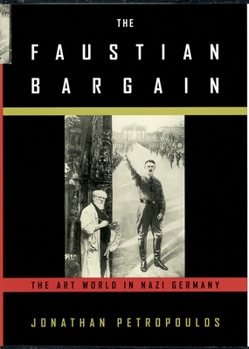The Faustian Bargain: The Art World in Nazi Germany
Select Format
Select Condition 
Book Overview
Nazi art looting has been the subject of enormous international attention in recent years, and the topic of two history bestsellers, Hector Feliciano's The Lost Museum and Lynn Nicholas's The Rape of Europa. But such books leave us wondering: What made thoughtful, educated, artistic men and women decide to put their talents in the service of a brutal and inhuman regime? This question is the starting point for The Faustian Bargain, Jonathan Petropoulos's study of the key figures in the art world of Nazi Germany.
Petropoulos follows the careers of these prominent individuals who like Faust, that German archetype, chose to pursue artistic ends through collaboration with diabolical forces. Readers meet Ernst Buchner, the distinguished museum director and expert on Old Master paintings who "repatriated" the Van Eyck brother's Ghent altarpiece to Germany, and Karl Haberstock, an art dealer who filled German museums with works bought virtually at gunpoint from Jewish collectors. Robert Scholz, the leading art critic in the Third Reich, became an officer in the chief art looting unit in France and Kajetan Muhlmann--a leading art historian--was probably the single most prolific art plunderer in the war (and arguably in history). Finally, there is Arno Breker, a gifted artist who exchanged his modernist style for monumental realism and became Hitler's favorite sculptor. If it is striking that these educated men became part of the Nazi machine, it is more remarkable that most of them rehabilitated their careers and lived comfortably after the war. Petropoulos has discovered a network of these rehabilitated experts that flourished in the postwar period, and he argues that this is a key to the tens of thousands of looted artworks that are still "missing" today.
Based on previously unreleased information and recently declassified documents, The Faustian Bargain is a gripping read about the art world during this period, and a fascinating examination of the intense relationship between culture and politics in the Third Reich.
Petropoulos follows the careers of these prominent individuals who like Faust, that German archetype, chose to pursue artistic ends through collaboration with diabolical forces. Readers meet Ernst Buchner, the distinguished museum director and expert on Old Master paintings who "repatriated" the Van Eyck brother's Ghent altarpiece to Germany, and Karl Haberstock, an art dealer who filled German museums with works bought virtually at gunpoint from Jewish collectors. Robert Scholz, the leading art critic in the Third Reich, became an officer in the chief art looting unit in France and Kajetan Muhlmann--a leading art historian--was probably the single most prolific art plunderer in the war (and arguably in history). Finally, there is Arno Breker, a gifted artist who exchanged his modernist style for monumental realism and became Hitler's favorite sculptor. If it is striking that these educated men became part of the Nazi machine, it is more remarkable that most of them rehabilitated their careers and lived comfortably after the war. Petropoulos has discovered a network of these rehabilitated experts that flourished in the postwar period, and he argues that this is a key to the tens of thousands of looted artworks that are still "missing" today.
Based on previously unreleased information and recently declassified documents, The Faustian Bargain is a gripping read about the art world during this period, and a fascinating examination of the intense relationship between culture and politics in the Third Reich.
Format:Hardcover
Language:English
ISBN:0195129644
ISBN13:9780195129649
Release Date:March 2000
Publisher:Oxford University Press
Length:416 Pages
Weight:1.73 lbs.
Dimensions:1.4" x 6.5" x 9.6"
Customer Reviews
3 ratings
An Academic and Moral Subject Undertaken in Engaging Fashion
Published by Thriftbooks.com User , 19 years ago
Jonathan Petropoulos, Professor of History at elite Claremont McKenna College, presents an academic subject with a style that reads as a "user-friendly" narrative. He explores the manner in which certain Nazi-era museum directors, art dealers, art journalists and art historians, and, finally, artists, themselves, negotiated the dangerous terrain of Hitler Germany in order to enjoy the benefits of Reich approval. Petropoulos keeps the reader aware of moral, ethical, and legal issues as he paints a damning portrait of opportunists, both talented and not, who sold their souls to the National Socialist devil. In the end, one is left with a sorrow for their choices, and, in all honesty, a realization that the art produced for this regime was weak, coarse, and ultimately foolish.
Fascinating reading
Published by Thriftbooks.com User , 24 years ago
Rather than producing another dry narrative of events in the artistic world during the Nazi era, the author brings the subject to life by taking a prosopographic approach: comparative biographies of a number of interesting figures in Nazi art (not only artists but critics, museum directors, etc.), following their careers both before and after 1945. A fascinating series of case studies. But I must agree with the previous reviewer that there are problems with editing: "prosopography" is misspelled throughout -- eek!
it covers all the types that stayed behind
Published by Thriftbooks.com User , 24 years ago
I've always wondered how I would have reacted had I lived in Germany in the 1930s. As a Jew, as a Lutheran, as a man or a woman, as an intellectual, as a peasant, as a business owner. The author does a fair job covering the members of the art world, artists, dealers, museum directors, critics. He picks one or two of the worst in each group and also a few shaded lighter grey. The only fact I would question is the name of the main Jewish bookdealer in Munich. Wasn't it Emil Hirsch rather than Heinrik Hirsch? Also it's slightly annoying to see some people's birth and death dates in brackets but not all and even more annoying to see a birth date and a questionmark for the death date. Did his editor not get around to filling in the dates?






